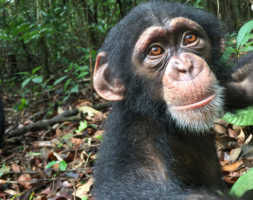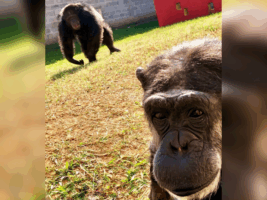Johnnys message

Two weeks ago, a team from an Argentinean TV spent two days at Great Apes and Cats Sanctuary of Sorocaba, affiliated to GAP Project, filming a long report to be aired, for the first time, in our neighbor country. The TV crew came along with Alejandra Juarez, representative of GAP in Argentina and owner of Caraya Sanctuary – monkeys in freedom, located in the hills of Cordoba, and Martin G. Davids, a chimpanzee keeper of the Zoo of La Plata.
Alejandra’s life and his involvement with primates, including apes, monkeys and chimpanzees in Argentina, will be the main subject matter of the TV report.
Chimpanzee Johnny, who arrived at Sorocaba several years ago, lived most of his life in a family home at São Paulo countryside, after he left Mexico when he was not four years old yet. He had a little experience of life in a zoo in Curitiba, where he lived with a female chimpanzee called Imperatriz – very humanized, who lived at the former Garcia Circus – and did not get along very well with her. After this experience his owners sent him to the sanctuary.
Johnny lives alone, because we did not find a partner that he would accept. We built a enclosure with tunnels on several levels, when we realized that he loved being there.
When someone visits him, Johnny tries to make treats. Generally, when someone gives him something, he likes to share with the person who took it. Martin Davids spent four days with us in the Sanctuary, along with Alejandra. He worked for over 20 years with chimpanzees in Argentina. He is one of the few keepers who enter in the enclosures with the chimpanzees, which points an emotional intimacy with them. For what is known, in Argentina there are no more chimpanzees in circuses. Regional laws, as in Brazil, banning the entry of animal in circuses, almost emptied them from the circuses. According to Martin, there should be from 15 to 20 in zoos of the country. At La Plata Zoo, where he works, there are five.
Martin tried to approach Johnny and he began to please him too. After a while he went to his bedroom at the third floor and dropped a small piece of tissue. To Martin’s surprise, it was a piece of tissue from the cap of GAP Project, where it could be read "Project GAP – www.projetogap.org.br."
Martin could not believe in what was happening. One chimp, whom he had known a few hours ago, asked him to help GAP, as it is a movement that promotes the struggle for their rights to be respected in the future and that all great apes are no longer abused, enslaved or tortured.
Johnny had received from me, a week before, that cap of GAP. He kept it in his bedroom and cut it into pieces. The part with the sentence above was in front of the cap, which he chose to deliver Martin the message, whom he quickly realized was a person who knew of its kind and knows how to treat them.
Martin was thrilled and kept the message. In the following day, hours before leaving, he was still surprised and could not believe in what had happened.
Martin worked for more than 20 years with chimpanzees, and knows about their intelligence, reasoning and feelings. He also knows that the only difference with us is language. Humans were able to articulate words and create an oral language less than 50,000 years ago. They were not. Maybe, someday, they will be able to, if we allow some to survive. But he is aware that chimps know how to express their desires, emotions and feelings in many other ways. This way chose by Johnny was not known: offer him a human language text, drawn from a hat, which meant all it was necessary. Johnny desired he was another defender of his species and their rights to a life of respect and decency.
There are many ways to express thoughts. Johnny did something very unusual, as long as he understands why we fight and how we express our thoughts to society. Someday, one of them will also be able to do it with words.
Dr. Pedro A. Ynterian
President, GAP Project International

 Español
Español
 Português
Português








